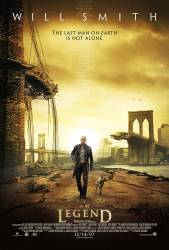Corrected entry: At the end he says that 1% of people are immune. That is 1% of 6 billion, and that is 60 million, not 12 million.
Corrected entry: There's just been a major zombie outbreak but humanity don't seem to have put up much of a fight as there's no sign of struggle anywhere (Smashed glass, abandoned barricades, spent bullets etc.).
Corrected entry: When Robert Neville is playing golf, the camera is rotating around and you see him hit the ball. As he says "yeah," you can see two balls in a line. The camera then goes back down so you can see the dog's face and Robert swinging. You cannot see the balls as they are hidden, but Robert then hits the ball towards the hole. However having seen the shot beforehand, there were only two balls to hit and he couldn't have hit either cleanly like that as they where in a line.
Corrected entry: All the 'spare' cars would be seized up and have other problems making them generally non-working from lack of use for 3 years.
Corrected entry: The Ford SUV was destroyed when Robert goes out and attacks the Dark Seekers; I think it was even flipped as well. So how can the same truck be driven, by the woman and the kid that rescued him, at the end of the film?
Correction: They have a virtually unlimited supply of vehicles to choose from, including entire car lots full of similar model vehicles.
Corrected entry: If 12 million people survived, 6,488,000,000 would become "darkseekers" to be exact, or 5,988,000,000 to count from 6 billion - not 588,000,000 as Roberts suggests, unless the population prior to the outbreak dropped to 600,000,000. The numbers are out by an order of magnitude.
Correction: He's referring to-non mutant survivors. The virus (approximately) kills 90%, mutates 10% and has no effect on 0.2%.
Corrected entry: When New York is quarantined, all bridges were destroyed. However, Anna and Ethan drive to pick up Neville. Also in the alternate ending, the three characters drive over a bridge to leave the island.
Correction: Firstly, we never see how they arrive in Manhattan, they could have come by boat. Secondly, the alternate ending wasn't ever used as the official ending, so their exit via a still useable bridge cannot be considered a mistake.
Corrected entry: When Dr. Neville and Sam are trapped in the building after chasing a deer, when they are running out of the building and Neville jumps out of the window, two dark seekers jump with him, but when they land there's only one.
Correction: In the last shot of that scene, a wide angle of Smith looking down at the darkseekers, you can see (DVD version) two darkseekers. The second is harder to see, but it is obviously there in the lower left corner of the screen.
Corrected entry: If pretty much everyone but Neville and a few colonies of survivors are dead, who is running the power plants so that he can have electricity in his house? And where does he get gas for his vehicles? Okay, he could siphon it out of other cars, but even that would start to run out after awhile. He does a lot of driving around.
Correction: There is a pretty clear shot in the movie that shows him having several generators in his house that are powering everything. And petrol is *everywhere*. Other cars, transport tankers, the tanks underneath gas stations etc. He even has access to a naval base, where there would be many fuel stores. The film also takes place in 2012, by which time there could have been advances in fuel efficiency, in terms of more efficient engines, or fuel additives.
Corrected entry: In the scene where Neville is hunting deer in his red Mustang, just after he slides to a stop, Neville looks out over the deer running away. Look to the very right in the dark shady building. You see what looks like a dog running away. I thought Sam was the only dog left? (00:05:15)
Correction: It is never stated in the movie that Sam is the only healthy dog left. There are other surviving dogs who have avoided getting infected, but they have most likely become wild.






Correction: The actual line in the movie is "...LESS than 1% immunity", not exactly 1 percent. He's making a point of how small the level of immunity was, not making an accurate statistical analysis.
Gary O'Reilly